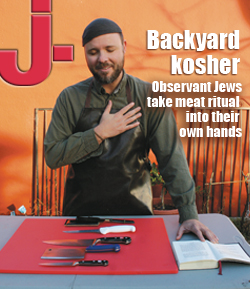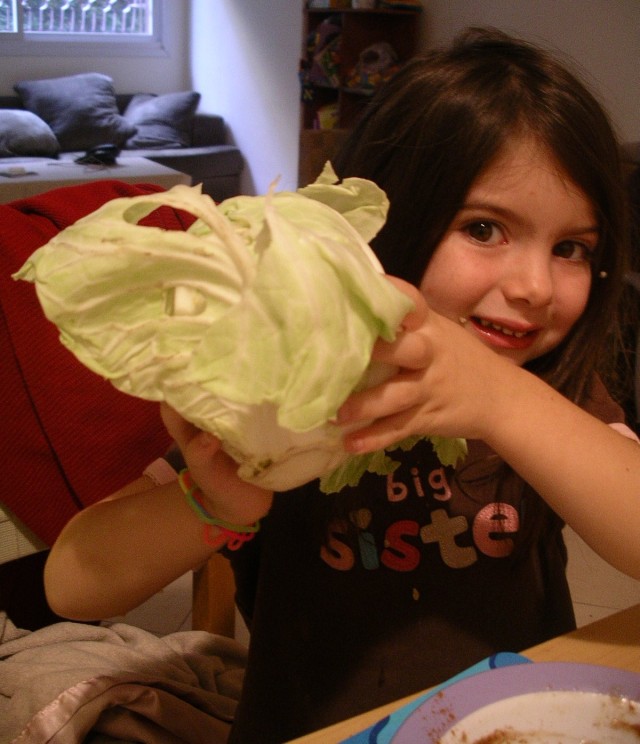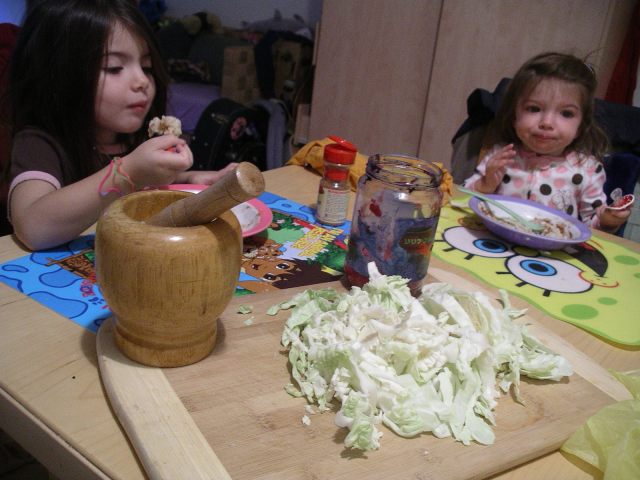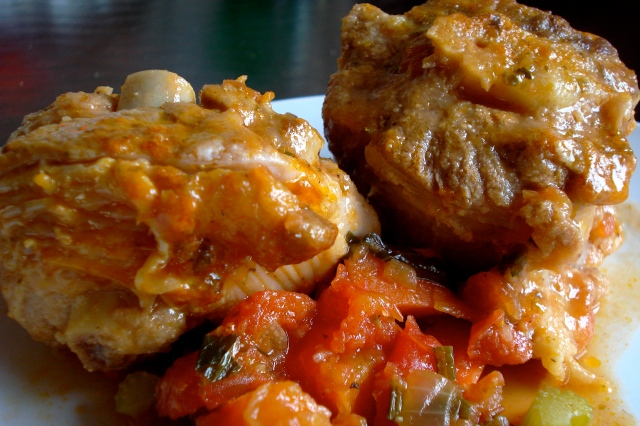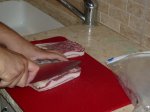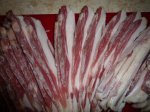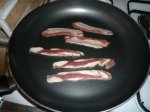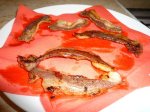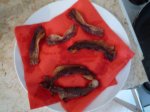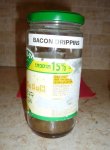-
Recent Posts
Archives
Categories
Meta
Good press!
Posted in Uncategorized
Leave a comment
Making Thanksgiving Dinner
On the Sunday before Thanksgiving, Josh and I went up to Sebastapol and Petaluma, CA and got our own live turkey to shecht and process for Thanksgiving dinner. With the help of some friends, we plucked and cleaned a 17 lb. bird in my backyard.
Posted in Food News, Turkey
4 Comments
Customer Tested and Approved!
Check out what Aharon at http://www.israelbbq.com said after trying out our bacon!
OK just made 1 batch in the frying pan. It looked a little too lamb-like at first but by the time it was ready it was definitely bacon! Pretty salty, but I think that’s how it’s supposed to be. I have never eaten the real thing but have seen and smelled it many times and this was what I imagined it would taste like..my candied bacon also came out very good.
Get some!
Posted in Uncategorized
3 Comments
Guest Post: Mat Tonti and Daughters
I just got back from family dinner at the Tonti/Rezmovic house. My first chili of the year with homemade schug, story time with the kids, some guitar playing, and homemade chocolate chip cookies have left me in a pretty darn good mood.
Mat and Julie are colleagues and friends, but what I really want from them is there pickling know-how from living on a farm for a while. In this guest post, Mat makes sauerkraut with help from some little cuties.
There are few thrills for me greater than creating good food. Add to that the magic of sharing the experience with my daughters May and Hami, and you’ve got an rollicking good time. In this instance we made sauerkraut. It works as a project on so many levels. Firstly, it’s easy. It involves a clean jar, a head of cabbage, and some salt. Secondly, the main actions to prepare the cabbage involve slicing it into ribbons, and then smashing the b’jebus out of it with a mortar and pestle. This action extracts the water nestled in its cellular walls. I will admit that I do not let my daughters do the slicing, but when it comes to the smashing I let them have at it. The amazing thing is that what we’re really doing is creating a habitat of salt water for certain bacteria to dwell, in this case it’s Lactobacillus. Essentially, we are inviting the Lactobacilli to colonize the jar, and start feasting on the cabbage. By ingesting and then excreting, the lactobacilli are essentially helping us in two ways. The bacteria breaks down the hard-for-humans-to-digest cell walls of the plant, and through its excretions it is actually helping preserve the cabbage, i.e. pickling it. It is no wonder that so many popular Ashkenazi foods are in fact pickled. It speaks to the historical fact that many of the countries in which my ancestors lived had short growing seasons and long winters. In order to preserve the foods that were grown in the ground, the best strategy was (and may still be ) to pickle them. That way, they could enjoy their carrots, beets, and cabbage all year round. And from generation to generation we carry on the tradition by enjoying them as well.
Sauerkraut goes quickly in our house. While it is a challenge to get my girls to eat vegetables (OY!), they always willingly maw down some kraut, especially when they’ve had a hand in making it. And that brings me to my next point. Sauerkraut is DELICIOUS! After three or four days of sitting out, the lactobacilli have really had their way, and the distinct flavor of the pickling comes out, but you could wait even longer than that. How much crunch versus how much pickle you want is a matter of personal taste. One thing to note is that it doesn’t take a huge amount of salt to create a good sauerkraut. I don’t have a fast number or ratio, but I’d suggest paying attention to how much salt you use the first time and playing around with the amount you use from batch to batch.
Finally, I’ll let you in on a family favorite use of the kraut: the veggie reuben. Good sliced bread, a nice spread, like Dijon mustard, fried tempeh, a slice of good cheese, (cheddar is always a favorite), and sauerkraut. Assemble the sandwich, and then fry both sides of the bread using butter. TO DIE FOR! Or, as my youngest would say: Yummmmm.
Posted in Guest Post, Vegetables
Leave a comment
Turkey Ossobuco
My Nana’s favorite meal was veal ossobuco preempted by a dry martini with extra ice on the side. I imagine she picked up this habit in Providence, Rhode Island where she raised my mom and her sister and spent most of her adult life. Providence has long had a strong Italian community and a good number of Geffner family stories involve Italian restaurants. Even today, my parents speak warmly of the great food in Federal Hill.
Though veal is readily available here in Israel, many people object and do not eat it. In addition, my college adviser wrote a tshuva for the Conservative movement’s Rabbinical Assembly regarding the kashrut status of veal based on tzar baalei chaim – the ethical treatment of animals. It was with these considerations that I decided to prepare an ossobuco Shabbat dinner with turkey legs.
Ossobuco means bone with a hole: osso – hole, buco – bone and comes from Milan. The meat is braised in white wine and turkey stock for a number of hours becoming more and more tender as time passes. The simmering stock and wine mix grows stronger in flavor as it becomes more concentrated. In addition, the broth thickens as the marrow from the bones seeps out.
Traditional ossobuco uses white wine and is flavored with cinnamon and a bay leaf. I used a newer version which calls for tomatoes. I consulted a recipe for Turkey Ossobuco and added some of my own ideas. I started with the bacon grease that I have been cooking with a lot since we started our bacon project. The grease is just the left over fat drippings collected from the bacon pan. 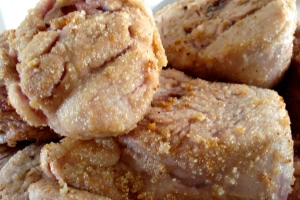
After that I browned my floured turkey leg pieces. Earlier that morning, I had run up to the shuk to buy some turkey legs which I asked the butcher to chop into three or four pieces. My wife Yael cannot eat gluten so I used a rice flour. This flour stayed on surprisingly well. By browning the legs it helped keep the juices sealed into the meat. Once these pieces were browned, I removed them from the pot, turned down the flame and added my mirepoix of onions, celery and carrots. The onions and celery quickly started to sweat while also picking up the flavor of the bacon grease and turkey left behind. To this mix, I added something not called for in the recipe – diced chard ribs. 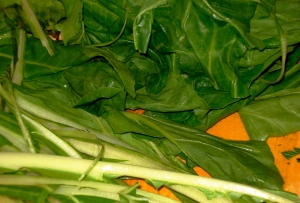 Chard is in season right now and we get a package of chard leaves every week in our CSA. I separated the ribs from the leaves, diced the ribs, and threw them in with the mirepoix. Later, after the broth had cooked down quite a bit, towards the end of the preparation, I added the chopped leaves.
Chard is in season right now and we get a package of chard leaves every week in our CSA. I separated the ribs from the leaves, diced the ribs, and threw them in with the mirepoix. Later, after the broth had cooked down quite a bit, towards the end of the preparation, I added the chopped leaves.
Once my mirepoix was good and sweaty, I added a few cloves of garlic, diced, and a can of crushed tomatoes. Then I placed my turkey pieces into the mix. I made sure that the turkey pieces were surrounded by the mix and not just sitting on top. Then I added a mixture of stock and white wine to cover the pieces. I let this mixture come to a rolling boil slowly uncovered, and then turned the heat down to let it simmer for a couple of hours. In the end, the broth was bold and flavorful and the meat was tender, falling from the bone with the simplest nudge. While it was not veal, I am sure my Nana would have loved the meal. There is something so comforting about braised meat dishes. They evoke warmth and friendship and are the perfect recipe for a cool autumn Shabbat.
* A quick note about the stock. I bought a turkey neck at the shuk, put a piece of it in a small pot and brought the pot to a boil. I let this simmer for about an hour (while I prepped everything else). This is how I got stock.
Posted in Turkey
2 Comments
Guest Post: Josh Pashman Makes Chiliquiles
We at Kosher Bacon love a couple things. One of them is Mexican food and the other thing is the Medina/Pashman family. Jenny and Josh have fed us countless meals in the past and we are always grateful for their friendship. Josh recently entered the Center for Kosher Culinary Arts‘ ‘Next Kosher Chef’ contest. We sincerely hope for his victory, but in the meantime, here is the video Josh made as part of his entry.
Chiliquiles para el desayuno o una comida cualquiera! ¿Qué sabroso!
UPDATE:
We’ve just heard that Josh has made it into the finals thanks to the Kosher Bacon Bump! The finals take place on December 12th. Good luck Josh!
Posted in Guest Post
Leave a comment
Restaurant Review – Darna
It was supposed to be a festive meal that promised exotic flavors in a beautiful setting, invoking the lavish dining culture of Morroco.
It turned out to be a wet turd in a rotten potato bag.
A number of years ago, I came to Darna with a large party of people visiting from my home community. I remember giant bowls of pillowy couscous which, when excavated, revealed perfectly cook chunks of lamb with impeccably seasoned, tender vegetables. A wide array of salatim sat on a lazy susan and were constantly being refilled. For reasons unknown, Darna has taken a steep dive from a once famed Jerusalem culinary destination to a sad backwater of Mid-Eastern kitsch and a menu which lacks both integrity and refinement.
My dining companion and I arrived early on a Thursday night, hopeful to beat a potentially overwhelming tourist rush. The place was as I remember it–an amazing brightly colored interior offset by low lighting, Moroccan folk music in the background, and large, comfortable seating arrangements both inside and in the outside courtyard. To our astonishment, there was only one other couple dining in the whole place, and we were awkwardly seated next to them. After deciding to find a more private corner, we were presented with the menu.
I had first noticed something off when we took a few minutes to review the menu, though we had taken some time to look over the restaurant’s website and knew what we were going to get beforehand. The server was very polite, though the famed forespice of various dips and salads never appeared. As she took our orders, we were also presented with a bottle of water which we happily received since there was nothing else with which to whet our appetites.
Both my companion and I ordered from the ‘Darna Traditional Menu’, which promised a starter, a main, and a dessert served with mint tea. After ordering, we sat in our small corner for more than fifteen minutes, patiently waiting for anything to eat while many servers decided to loudly review the menu in English just a few feet from us while the restaurant remained empty.
Our starters arrived just as I began to start chewing on my napkin. We both ordered a pastilla, hers vegetarian and mine the fassia, which promised to be filled with Cornish hen. Regarded as the national dish of Morocco, the pastilla is traditionally a savory/sweet meat pie encased in phyllo and covered with sugar and spices. Our pastillas came out on very small plates, and ravenous at this point, we hurriedly cut into them. My pastilla was neatly decorated with fine perpendicular lines of powdered sugar and cinnamon. Searing hot, the phyllo was crispy and sweet, though the filling was entirely unimpressive. Indistinguishable from regular chicken, the Cornish hen seemed to have been cooked in an unseasoned broth and did not contain the traditional ground almond layer. Except for the wonderfully crunchy exterior, there was nothing that elevated this dish– no subtleties in spicing, herbage, or texture.
To call my companion’s vegetarian version a disaster would be an understatement. The only memorable vegetable in the mix was zucchini, but their was an almost rancid flavor that permeated the entire thing. It was as if there was a rotten box of vegetables in the back and the chef decided that instead of taking a loss, the kitchen would wrap it in enough phyllo dough and sugar that no one would ever know they were eating compost. Well Mr. or Mrs. Chef, we knew. We knew.
The experience with our starters basically colored the rest of the meal. The next course was the real reason I was excited about coming to Darna: the tajine. In America, the tajine is kind of entering into haute cuisine by retailers such as Sur La Table and William Sonoma. At Darna, it is supposed to be the main event. I was going to order the lamb tajine with vegetables, but my server recommended the lamb with fruit and I happily accepted her advice. There was no fanfare when the conical vessel arrived, but I was excited when that big puff of steam rose from the still bubbling base of meat and fruit.
Then I ate it. Immediately noticeable was the strange ratio of meat to fruit. The three “lamb cuts on the bone” took a back seat to the handfuls of raisins, dates, apricots, and blanched almonds. The meat was hot and flavorful, and as you may have read on this blog elsewhere, I am a huge sucker for lamb fat. Another displeasing feature of the dish became quickly apparent: everything had been covered in a thick syrup which began to completely coat the inside of my mouth and teeth and once cool, it made the dish unappetizing and inedible. Before I stopped eating it, though, I was given the gift of several date and apricot pits…the first one took me by surprise and I was afraid I had chipped a tooth. When I alerted the server about this (for which I believe would get you kicked off of Top Chef), she said “Oh, I should have told you. Sorry.”
My companion’s main dish is hardly worth mentioning at this point, except to make it clear that the experience with our starters coupled with the dissatisfaction from our mains began to result in what Ira Glass would consider a ‘fiasco‘. The lack of any dips and bread, even with the uninteresting pastilla and the fact that our water glasses were never filled after we polished off the expensive bottle of water, would have been forgivable had my tajine and her couscous been exceptional. Instead, misstep after misstep negated any principle of charity we could allot to a kitchen with very few orders coming in while we were dining and a lofty reputation to uphold. We now expected whatever came out of the kitchen to be a disaster and we wanted blood.
The kitchen did not disappoint. Our dessert course was the ‘toukbal delight’, sweet phyllo layers in cinnamon and almond milk and Moroccan pastry platter. The toukbal delight brought us back to the beginning, the poor pastilla, now covered with a thick and unappetizing cream which quickly saturated the phyllo and looked like a dirty Mexican pizza from Taco Bell. The Moroccan pastries put the fiasco into high gear. Having a strong dislike for rosewater and the fact that ever pastry was covered in it, I actually spit food into my napkin and left it on the table. Happy that it was finally over, we paid the bill, said goodnight and walked home, disgusted and dissatisfied, knowing we could have had a better meal at a fraction of the cost at Maoz down the street.
It pains me to write the following words, but this may be the worst meal I have paid for in very long time. I wanted to enjoy Darna so much. I wanted a simple, delicious meal from a cuisine that I do not have much experience with in my own kitchen, and was let down. The experience of going out to eat is essentially an exercise in trust; I, the diner, promise not to do anything but sit here politely and accept that you will serve me food with a high retail mark up, but it will ultimately (hopefully) enrapture me. For someone who likes to cook high-quality food at home, the stakes are even higher. A restaurant needs to convince me that I can’t do what they do (ambiance notwithstanding) in my own kitchen. Darna failed miserably at this.
Posted in Restaurant Review
Leave a comment
Bacon Shakshouka
I have eaten lots of shakshuka. The North African dish of stewed tomatoes and poached eggs is as close to the national dish of Israel as it comes. Yes, falafel was marketed well by the Jewish Agency as the food of choice in Israel, but one can find shakshouka on more menus. It is sold at the local shwarma stand, the 24 hour cafe and even the high school kiosk. Shakshouka comforts me when the cold and rainy Jerusalem winter has crept into my bones and it lounges with me during late morning brunch. I have eaten it with goat cheese, with spinach, with merguez sausage and now with bacon.
One of my favorite restaurants in Israel is called Doctor Shakshouka. Hidden among the alleyways of Jaffa, Dr. Shakshouka serves up some tasty medicine. It was the first place I ate shakshouka with meat. And it was my experience there that spawned my own doctorate in shakshouka: Bacon Shakshouka.
In addition to Dr. Shakshouka, the other source for this dish was a recipe offered by Jill Santopietro, who used to work for the New York Times and is now at Chow.com. In a segment called Tiny Kitchen she presented the recipe for Uova al Purgatorio or “eggs in purgatory” which is an Italian version of shakshouka served over polenta.
For my shakshouka I made the ragu first in a pot and then transferred it to a pan. I made the ragu with some grilled tomatoes and peppers and then added onion, canned tomatoes, garlic, tomato paste, and a small left over nub of bacon. Here is one recipe for shakshouka to play with. Obviously, if making it with lamb bacon (and kosher), you need to leave out the cheese. I sauteed the onions and garlic then added the grilled tomatoes and peppers which I had cut up and stored. I used one hot pepper, 2 sweet peppers and about 6 tomatoes. Then I added a small can of whole tomatoes which I cut up and half a small carton of tomato paste. Finally, I added the nub of lamb bacon and let it stew for 1.5 hours. This made enough for Yael and I with a bunch of ragu left in the pan (though no more room for eggs).
Once I was ready to eat, I fried of some lamb bacon in a pan and cooked it about 80%. Then I removed the bacon and added the ragu to the bacon fat that had collected in the pan. After a few stirs I added my eggs and covered for a bit. I like my eggs runny so once the whites were firm I added my bacon back to the ragu, sliding some slices under the eggs. I let it sit for another minute and then removed from heat. Shakshouka is served very hot so we waited a few minutes before we dug in. Just like really hot pizza, shakshouka is a great way to burn one’s mouth.
Posted in Bacon
2 Comments
Restaurant Review – 1868
On Thursday night Yael and I went out to dinner to celebrate our birthdays. We had been looking forward to a nice meal for a while and were thrilled with the experience at 1868. In the 8 years that I have lived in Israel, I have never had as nice meal as the one I had Thursday night. The service was excellent, the ambiance delightful and the food was excellent.
In my mind, 1868 has been around as long as I have lived in Jerusalem, though in a number of different locations. I also do not remember it being known as one of the better restaurants in Jerusalem until recently. One friend, who raves about it, said that it came under new ownership in recent years. Another friend claims the food is mediocre – just fancy. In any event, we had a great time.
Upon arrival we were quickly shown our table. The restaurant seems to be made up of a number of small dining rooms. In our room sat another couple and a group of four. It was cozy, intimate and the music playing was great. It was mostly Erica Badu though at the end we got a little Bill Withers and some School House Rocks. It was not too loud, just pleasant.
We were quickly visited by the sommelier and then our server. Yael ordered the evening’s cocktail made of fig liquor, vodka and pomegranate juice, while I waited to order wine until after making my meal choice.  After ordering, we were brought a basket of three breads which included a slices of a country loaf with a bit of cinnamon, a small french baguette, and two small sour dough roles. These were served with a plate of olive oil and balsamic and a small dish of homemade aioli. Though Yael is gluten-free and I have adopted that minhag, I broke it because this bread was divine.
After ordering, we were brought a basket of three breads which included a slices of a country loaf with a bit of cinnamon, a small french baguette, and two small sour dough roles. These were served with a plate of olive oil and balsamic and a small dish of homemade aioli. Though Yael is gluten-free and I have adopted that minhag, I broke it because this bread was divine.
The first course was served quite quickly. Yael orderd the calf’s sweetbreads and I had the roasted foie gras. The sweetbreads were served “ras el hanout” which refers to a spice blend often mixed with cinnamon, cardamon, cumin, coriander, paprika and other North African flavors that means “top of the shop.” The sweetbreads were then grilled and served over an onion cream, roasted red pepper coulis and with fava beans. 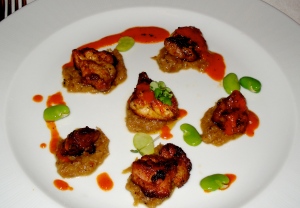 As this was both of our first time eating sweetbreads we can only compare it to other foods we have eaten. None the less, it was clear why these glands are such delicacies. They were literally bursting with flavor. They were salty and silky, chewy but in a good way. My difficulty in evaluating them is that I was eating foie gras, which is what I would probably eat everyday for the rest of my life if I a) had the money, b) wasn’t going to die an early death from cholesterol and c) had the money. This stuff is like meaty butter. It was so good. I literally wanted to take a bath in foie gras! By roasting the foie gras I ended up with a few pieces of caramelized ends and a milky center. It was a meat candy bar.
As this was both of our first time eating sweetbreads we can only compare it to other foods we have eaten. None the less, it was clear why these glands are such delicacies. They were literally bursting with flavor. They were salty and silky, chewy but in a good way. My difficulty in evaluating them is that I was eating foie gras, which is what I would probably eat everyday for the rest of my life if I a) had the money, b) wasn’t going to die an early death from cholesterol and c) had the money. This stuff is like meaty butter. It was so good. I literally wanted to take a bath in foie gras! By roasting the foie gras I ended up with a few pieces of caramelized ends and a milky center. It was a meat candy bar. 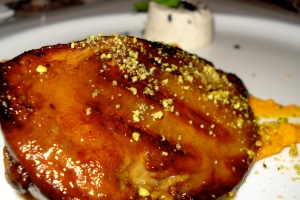 It was served over a carrot vanilla veloute (one of those words I did not know of until I started watching Top Chef) with a frozen shallot mousse on the side. The veloute was thicker than most veloutes are supposed to be, it was more like a puree. That being said, the bite of foie gras with a helping of carrot and that cold spot of mousse was a symphony of flavor and texture. Like smooth jazz if smooth jazz was good. My meal was paired with a small glass of sweet dessert wine that was generously offered to me on the house. I had told the sommelier that I was a one-glass-a-night kind of guy but that I wanted something that would work well with both the foie gras and my main – the lamb. He responded by bringing me a small glass of the Yarden sweet dessert wine which was just the right addition to an already great beginning.
It was served over a carrot vanilla veloute (one of those words I did not know of until I started watching Top Chef) with a frozen shallot mousse on the side. The veloute was thicker than most veloutes are supposed to be, it was more like a puree. That being said, the bite of foie gras with a helping of carrot and that cold spot of mousse was a symphony of flavor and texture. Like smooth jazz if smooth jazz was good. My meal was paired with a small glass of sweet dessert wine that was generously offered to me on the house. I had told the sommelier that I was a one-glass-a-night kind of guy but that I wanted something that would work well with both the foie gras and my main – the lamb. He responded by bringing me a small glass of the Yarden sweet dessert wine which was just the right addition to an already great beginning.
Between courses we had a light cranberry pomegranate cinnamon granita to cleanse the palate. It was lite with just a touch of cinnamon. It was the perfect in between ushering us from our first plate to our second. The granita was taken, my Syrah was poured and out came my lamb chops and Yael’s duck breast.
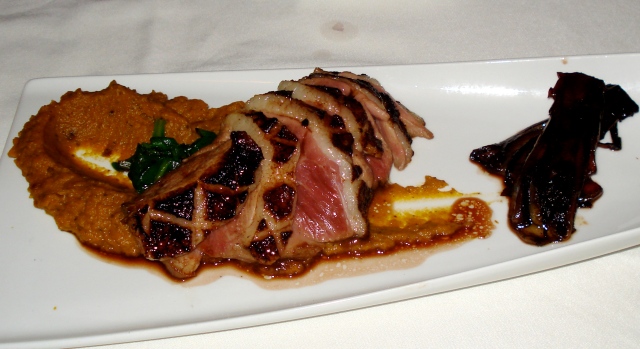 The duck was cooked quite rare, in fact our waiter pointed this out to us upon ordering. On a previous visit to La Guta I ordered the mallard and was rather disappointed. The breast had been over cooked and over sauced. Here though the breast was done perfectly. A nice layer of fat protecting the breast had been seared and caramelized while the meat itself stayed moist and juicy. It was served over a puree of pumpkin and sage and a side of caramelized endive hearts. Of the endive hearts, Yael’s exact words were, “they were the best thing ever.” Since she is easily sold on a sweet and savory mix, the duck was the right dish for her, but the endive hearts added the necessary sweetness to the duck.
The duck was cooked quite rare, in fact our waiter pointed this out to us upon ordering. On a previous visit to La Guta I ordered the mallard and was rather disappointed. The breast had been over cooked and over sauced. Here though the breast was done perfectly. A nice layer of fat protecting the breast had been seared and caramelized while the meat itself stayed moist and juicy. It was served over a puree of pumpkin and sage and a side of caramelized endive hearts. Of the endive hearts, Yael’s exact words were, “they were the best thing ever.” Since she is easily sold on a sweet and savory mix, the duck was the right dish for her, but the endive hearts added the necessary sweetness to the duck.
My lamb chops were served bone in, resting on small disks of lamb shoulder. The dish highlighted the variety of flavor and texture naturally found in the lamb. In addition was a bit of roasted eggplant, a small tomato tart, and a cilantro sauce. The chop was perfectly broiled. The chop is what I think of when I think of lamb, gamy but also the taste of spring. The shoulder on the other hand had clearly been slow cooked, its flavor was lighter, more subtle. 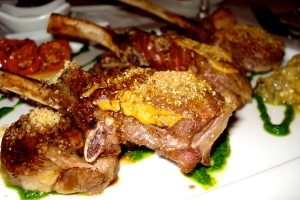 The shoulder was the one part of the meal that was not to perfection as it had dried out a little bit (this may be the nature of the shoulder, I have never had shoulder that I would call succulent). While the eggplant was smokey and flavorful, I am not one for plain eggplant so I cannot speak to its merits. However, I do know tomato tarts and I can speak highly of the smokey sweet tomato tart that accompanied my lamb chops. It was a small filo dough disk topped with a homemade smokey ketchup, though it was thicker, like a pate, and topped with sliced roasted cherry tomatoes. It was sweet, tangy and smokey. Absolutely lovely.
The shoulder was the one part of the meal that was not to perfection as it had dried out a little bit (this may be the nature of the shoulder, I have never had shoulder that I would call succulent). While the eggplant was smokey and flavorful, I am not one for plain eggplant so I cannot speak to its merits. However, I do know tomato tarts and I can speak highly of the smokey sweet tomato tart that accompanied my lamb chops. It was a small filo dough disk topped with a homemade smokey ketchup, though it was thicker, like a pate, and topped with sliced roasted cherry tomatoes. It was sweet, tangy and smokey. Absolutely lovely.
We ended our meals with dessert. As plums are in season they played a prominent role in both of our meals. I had a deconstructed mille feuille, a layered dessert of filo dough, pistachio cream and plums bathed in a liquor. While Yael had stewed plums and ice cream. With our check we were presented with two small cookies as a parting gift. They were chocolate cookies dusted with powdered sugar. The best part is that they were chocolate Kalamata olive cookies. The cookies were a fitting end to a meal that felt both old and new, classic and modern. 1868 took traditional French cooking and melded it with the local flavors of the Middle East served in updated form for the 21st century.
Posted in Restaurant Review
1 Comment
Kosher Charcuterie: Slice It and Fry It: A Photo Retrospective.
Ok…ok…I wanted to spend more time writing about each of the pictures and the experience of eating bacon for the first time in more than a decade, but YOU just want to see the finished product. Fine. Here are the final pictures to our first run. In the meantime, we’ve got three more bellies curing in the fridge….
The end result, friends, was smoky, salty, sweet bacon. We were so ecstatic at the first tastings that Josh started doing that jump up and down thing he does where he does a weird thing with his hand (you know that move?).
Instead of talking about the process, I’m just going to share the pictures of the last step in our first attempt.
Step #5: Slicing and Frying
Too sleepy to go into all the specifics, but Josh and I will post some video soon to run down the best way to slice and cook. Enjoy!
Posted in Bacon
5 Comments

